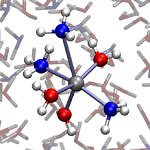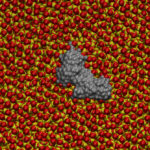HPC User Report from S. Sansotta (Professorship of Theoretical Chemistry)
Molecular Dynamics Simulation of Metal Patch Formation on Silica Nanoparticles
HPC User Report from S. Sansotta (Professorship of Theoretical Chemistry)
Molecular Dynamics Simulation of Metal Patch Formation on Silica Nanoparticles
Nanoparticles covered with metal patches are of interested for their unique properties and potential application for optics and catalysts, through the creation of complex structures. The shape of the patch can greatly change upon varying the experimental conditions. We investigate Ag+ association and the growth of silver patches from solution by means of molecular dynamics simulations.
Colloidal nanoparticles have been of interest of the scientific community for many decades, the use of particles with functional groups opened a new world of possibilities enabling, for example, the creation of particles with mixed properties. In particular patchy particles can be used to create new materials using the self-assembly of nanoparticles as building blocks. The shape of the metal patch is strongly dependent on the reaction condition, in order to have a reliable product we need to keep the shape of the patch as constant as possible. Thus the investigation of the growth of the patch over the nanoparticle is of great importance.
 We use the molecular dynamics code LAMMPS. For the growth of metal patches the Kawska-Zahn method is adopted. For the investigation of the metal patch shape the Charge Equilibrium Method (qeq) is used. To check the validity and to extrapolate the parameters for the qeq method DFT calculation using the software Quantum Espresso are performed. For the post processing the root libraries for C++ are employed.
We use the molecular dynamics code LAMMPS. For the growth of metal patches the Kawska-Zahn method is adopted. For the investigation of the metal patch shape the Charge Equilibrium Method (qeq) is used. To check the validity and to extrapolate the parameters for the qeq method DFT calculation using the software Quantum Espresso are performed. For the post processing the root libraries for C++ are employed.
Using the RRZE’s HPC we were able to create a model for the silica surface, we made a complete study on the diffusion of silver ions in solution and also studied the diffusion and behavior of silver nanoparticles in solution.
 The first publication was on the diffusion of silver ions in water solution (The Journal of Chemical Physics 147, 114506 (2017); https://doi.org/10.1063/1.5003654).
The first publication was on the diffusion of silver ions in water solution (The Journal of Chemical Physics 147, 114506 (2017); https://doi.org/10.1063/1.5003654).
Researcher’s Bio and Affiliation
Sansotta Stefano obtained his Bachelor and Master degree in chemical engineering at “La Sapienza University of Rome” and is currently a Ph.D. student in the group of Prof. Dr. Dirk Zahn at the Computer Chemistry Centre.